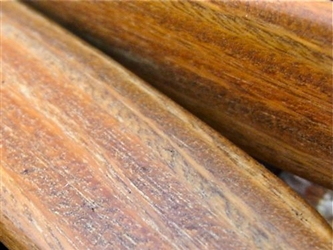 |
Verawood
Verawood is a rare exotic wood from South America that delivers a strong sharp tone.
Verawood ranks among the heaviest woods in the world. The material is very dense and exceptionally rigid.
Verawood is a good choice for handheld musical instruments because it is amazingly waxy which makes it impervious to skin secretions. And it is a super strong wood that can take a great amount of physical abuse. That's the perfect combination for a serious bone rattler. How durable is Verawood? Reports claim the heartwood can last indefinitely in the ground without chemical preservatives. What's more, Verawood can outlast treated timbers used as piling and fence posts. So if you long for Lignum Vitae but are watching your pennies, then this Poor Man's Ironwood is for you.
Figures below are approximate (but pretty darn close)
Tonality
Poor Man's Ironwood
Verawood is a "cousin" of Lignum Vitae, the world's hardest and densest wood. That is why some folks call Verawood "ironwood." But any wood with a reputation for hardness can be called ironwood. Ironwoods in this store include:
-
Lignum Vitae (Guaiacum officinale)
-
Michigan Ironwood (Not sure of the species, but it probably grows near the town of Ironwood, Michigan.)
-
Verawood, aka Argentine lignum vitae (Bulnesia sarmientoi/Arborea)
Can't Decide Which Bones to Choose?Check out this handy guide: Bone FAQs
|
|
Verawood Facts
Botanical Name
Bulnesia Arborea
Bulnesia Arborea is an evergreen tree native to Colombia and Venezuela. It is cultivated for its buttery-yellow flowers and valuable hard and heavy timber called Verawood or Maracaibo Lignum Vitae. Bulnesia Sarmientoi, known commercially as Argentine Lignum Vitae, is related to (but not the same as) Bulnesia Arborea, known commercially as Verawood. Neither Bulnesia variety is genetically related to genuine Lignum Vitae which is of the genus Guaiacum.
Grain
The wood often shows an interlocked cross-grain pattern that gives it a herringbone appearance.
Texture
Verawood is exceptionally fine textured and resinous. It gives off a bright green dust when sanded or cut. The wood is amazingly waxy and takes an extremely high natural polish.
Heartwood Color
Golden Olive (green caramel apple ripple)
The heartwood varies from light olive green to chocolate brown. The surface of the wood often turns dark green on exposure to mild sunlight. The timber is more or less striped and banded. It can be similar to Lignum Vitae in appearance, but is brighter green in color and has a more attractive figure.
Sapwood Color
The sapwood is mostly thin and light yellow in color.
Aroma
Verawood releases a mild and pleasant scent when warmed.
Other Names
Bera cuchivaro
Bera
Berra
Congo cypress
Cuchivaro
Guayac de caracas
Guayacan de bola (Colombia)
Guayacan de bola
Guayacan polvillo
Guayacan resino
Guayacan
Maracaibo lignum-vitae
Maracaibo
Palo sano
Venesia
Vera aceituna (Venezuela)
Vera aceituna
Vera amarello
Vera amarilla
Vera azul
Vera blanca
Vera pocktree
Vera
Veraholz
Vera wood
Environmental Profile
Verawood is reported to occur in small numbers and is becoming even rarer, which makes it very expensive. The species also grows very slowly, and is reported to require centuries to mature. It is not known at present whether timber from this species is obtainable from sustainably managed or other environmentally responsible sources.
Distribution
Verawood is native to the coastal regions of Colombia and Venezuela. It is common on the dry foothills between Puerto Cabello and Lake Maracaibo in Venezuela.
Tree Data
The tree is reported to be comparatively smaller than most tropical timbers. It occasionally attains heights of 100 feet (30 m), but it is typically 40 to 50 feet (12 to 15 m), with trunk diameters of 14 to 20 inches (35 to 50 cm). The tree is free of branches for 15 to 20 feet (5 to 6 m). Trees growing under the best conditions are reported to develop well-formed boles (trunks) that are well suited for timber production.
|
|
|